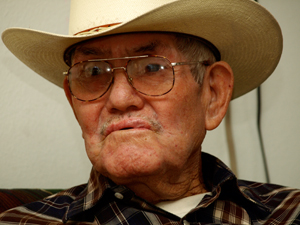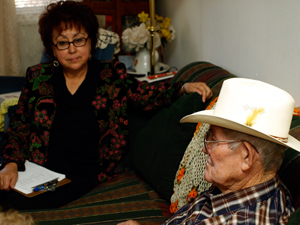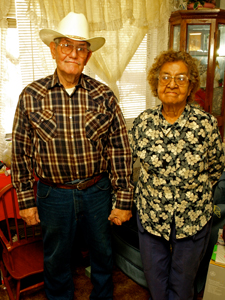Rubén Ramírez
Bracero Oral History Project
Date: February 25, 2008
Interviewee: Rubén Ramírez
Location: Greeley, Colorado
Interviewer: Dr. Priscilla Falcón
Hours Didn’t Matter
Ramírez: “I was born on August 5, 1934 in Praxedis G. Guerrero, Bravo District of the state of Chihuahua, Mexico. My mother and father were born in the state of Sonora, Mexico. They were agricultural workers. My parents owned a small ranch near the United States border in the community of Praxedis G. Guerrero. They planted cotton, corn, and alfalfa by which we fed our animals.
“I grew up with six brothers and sisters. My sisters were Kika, Evanjelina, and Manuela, and my brothers were Reymundo, Edwardo, Raul, and myself, Rubén. My sisters live here in Johnstown and Milliken ... and my only living brother is a pensioner and he travels back and forth to Mexico, living on the rancho our parents left to us.
“Well, ... I began work at an early age...you know in those days one worked as a young child...I must have been about eight.....I worked on the rancho helping my father with the mules...planting corps for our living.
“I learned farm work from my father.....that was my first job...that was my training for life.”
Falcón: How did you find out about the Bracero Project?
Ramírez: “Well at the time the municipal presidents of the pueblos received letters from the Mexican government...The municipal presidents were asked to make a list of all of the available young men that could travel to el Norte, the United States to work. At the time I was about 17 or 18 years old. I needed to help my family...we had economic necessities and so I began to investigate the Bracero Project.

Photo by Michael Soloway
Rubén Ramírez
“In the process of being contracted as a Bracero, I have to apply at the office of the Municipal President for permission. Once the office provided certification then I was placed on a list and sent to the capital, Chihuahua, Chihuahua. In Chihuahua the enlisted men from my municipality had to be presented by the municipal authorities from Praxedis G. Guerrero to the Contracting Center or Recruiting Station. This center was extremely large. Many people from all over Mexico arrived at these centers.....maybe 3,000 to 5,000 people.....and we stayed there many days until the contracts came from the United States. At the Contracting Center in Chihuahua we were given a number and a letter of authorization to travel to the United States.
 Photo by Michael Soloway
Photo by Michael Soloway
The interview with Rubén Ramírez
“When contracts from the United States came we were transported from Chihuahua to Ciudad Juárez by cargo train. Cargo trains were contracted to carry Braceros to the border stations. Cargo trains are those that carry coal, supplies, and animals. Once the trains arrived at the train depot in Juárez we were told to walk to the bridge...there we were met by United States Immigration agents. At that point they lined us up and made us pass through a little house. Before entering that house, we were told to take off all our clothes...upon entering the house we were sprayed with a white powder all over our bodies....from there we went outside put our clothes on, signed some papers and were taken to a holding center called Rio Vista. There we again had to wait for local ranchers to select workers...there were thousands of Braceros waiting to be assigned......
“Sometimes we were contracted right there in El Paso, Texas. Other times we were contracted to work outside the valley and in that case you waited until your turn came up to travel to New Mexico, Colorado, or into other cities in Texas.
“I was a Bracero for four years. I worked only in agriculture mainly picking cotton. My first job as a Bracero was picking cotton in Deming, New Mexico. I was also contracted in Pecos, Texas, and in Lovington, New Mexico. When you pick cotton you tie a large bag around your shoulders and pull it down the rows until you fill it up...it gets very heavy after six or seven hours of work....but the short hoe was the worst. My last contact was in 1963 that was the year Kennedy was killed.
“Men from all parts of Mexico worked with me during my years as a Bracero...some patrons’ ...you know the bosses...some were nice but most were not pleasant.... They would put us in the houses that were used for animals, and no services like water or light. They worked us from sun up to sunset, squeezing every bit of labor out of us.....and when we got sick and couldn’t get out of bed...only then would they call a doctor.
“We worked every day of the week....the seven days of the week...and if we did not want to....we had to because it was part of the contract. The bosses would tell us ‘You came here to work not to rest.’ Some days we worked eight hours a day, but most of the time we worked ten or twelve.... We didn’t always go by hours... Sometimes we were paid by the weight, like when we picked cotton. When we worked by the hour we were paid fifty-cents an hour and many times whatever the boss decided to pay us.
“We were paid in cash every 15 days, and I sent money home by mail. In those days, there was no Western Union.
“We made our lunches for work every day and when the boss said to have lunch we ate. We washed our clothes in tubs and hung our clothes outside to dry.”
End of interview.
(end of tape)

Photo by Michael Soloway
Rubén and María Ramírez

